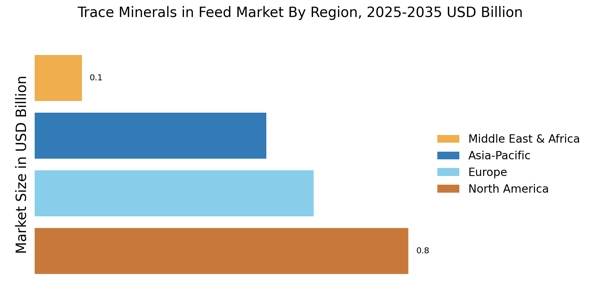Expansion of Aquaculture Sector
The expansion of the aquaculture sector is emerging as a key driver for the Trace Minerals in Feed Market. As the demand for seafood continues to rise, aquaculture is becoming an increasingly important source of protein. Trace minerals are vital for the health and growth of aquatic species, and their inclusion in fish feed formulations is essential for optimizing production. The aquaculture industry is projected to grow at a compound annual growth rate of around 6%, which is likely to boost the demand for trace minerals. This growth presents significant opportunities for manufacturers to develop specialized feed products that cater to the nutritional needs of various fish species.
Rising Demand for Animal Protein
The increasing The Trace Minerals in Feed Industry. As consumers become more health-conscious, the need for high-quality animal products has surged. This trend is reflected in the projected growth of the livestock sector, which is expected to expand significantly in the coming years. Trace minerals play a crucial role in enhancing the nutritional value of animal feed, thereby improving livestock productivity and health. The market for trace minerals is anticipated to witness a compound annual growth rate of approximately 5.5%, indicating a robust demand for these essential nutrients in feed formulations.
Growing Awareness of Animal Welfare
The rising awareness of animal welfare is significantly impacting the Trace Minerals in Feed Market. Consumers are increasingly concerned about the ethical treatment of livestock, which has led to a demand for higher welfare standards in animal husbandry. Trace minerals are essential for maintaining the overall health and well-being of animals, and their inclusion in feed formulations is seen as a critical factor in promoting animal welfare. This trend is prompting livestock producers to invest in high-quality feed that meets these welfare standards, thereby driving the demand for trace minerals in feed. The market is expected to benefit from this shift towards more humane and responsible animal farming practices.
Regulatory Support for Nutritional Standards
Regulatory frameworks aimed at improving animal nutrition are influencing the Trace Minerals in Feed Market. Governments and regulatory bodies are increasingly recognizing the importance of trace minerals in promoting animal health and productivity. This has led to the establishment of stringent nutritional standards for animal feed, which necessitates the inclusion of essential trace minerals. For instance, regulations in various regions mandate specific levels of minerals such as zinc, copper, and manganese in feed formulations. This regulatory support not only enhances the quality of animal products but also drives the demand for trace minerals, thereby fostering growth in the market.
Technological Advancements in Feed Production
Technological innovations in feed production are reshaping the Trace Minerals in Feed Market. Advances in feed formulation technologies, such as precision nutrition and feed additives, are enabling manufacturers to optimize the inclusion of trace minerals in animal diets. These technologies facilitate the development of customized feed solutions that cater to the specific nutritional needs of different livestock species. Moreover, the integration of data analytics and artificial intelligence in feed production processes is enhancing the efficiency and effectiveness of trace mineral utilization. As a result, the market is likely to experience increased adoption of innovative feed solutions that incorporate essential trace minerals.


















Leave a Comment